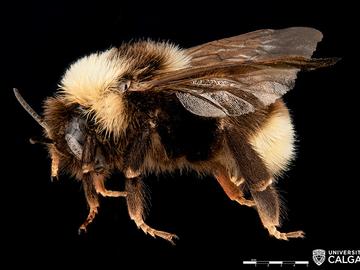May 17, 2019
Digital bee collection launched at University of Calgary

What’s abuzz at the University of Calgary?
Thanks to a collaborative project between the Faculty of Science and Libraries and Cultural Resources (LCR), a new digital collection of native Albertan bee species is now available to researchers and bee lovers across the globe.
Dr. Paul Galpern, PhD, associate professor in the Department of Biological Sciences, is interested in understanding bees and other beneficial insects as a means to promote conservation on agricultural and urban landscapes. The majority of the bees in this online resource were collected by members of his research group. Their work since 2015 has grown the university’s physical bee collection to over 100,000 specimens, making it one of the largest in Canada.
“Knowing which bees live in specific areas of our province or country can help answer questions like how to design cities for bees,” says Galpern. “Or how to select the right plants for pollinators in the designs we create.
“Most importantly,” he adds, “it can help us identify and protect endangered bee species like the Gypsy Cuckoo Bumble bee Bombus bohemicus, which was recently discovered in the Canyon Meadows area of Calgary.”
An interdisciplinary project
The first 246 bees were digitized as part of a collaboration between the Faculty of Science and LCR. Funding to add to the digital collection and create a complementary Biodiversity website came from a sub-grant under the project Academic Research and University Libraries: Creating a New Model for Collaboration, led by Tom Hickerson in LCR and funded by The Andrew W. Mellon Foundation. BeeASmartCity is one of several research projects under this unique initiative.
Dr. Mindi Summers, PhD, an ecology and evolutionary instructor in biological sciences, leads the BeeASmartCity project. “We knew we had an incredible collection of native Albertan bees and lots of ideas on how to share this resource with other researchers, teachers and bee enthusiasts.”
A multidisciplinary group from biology, engineering and landscape architecture developed a successful application for the sub-grant that funds both the continued digitization of the bees and development of the website that will launch this summer.
“This website will be a great resource for a lot of different stakeholders,” Summers explains. “Through the website, visitors will be able to explore the digital collection, link to the physical collection’s database, access planting guides for bees and much more.”
Time-intensive digitization process
Rob Alexander manages special projects for Digitization and Repository Services in LCR and is overseeing the creation of this new invertebrate collection. He works with students hired to work on this project.
“We began photographing the bee specimens in January 2018 after I experimented with the photographic process and stacking software for a couple of weeks,” says Alexander. “The bees are shot from three points of view: front, side and from above. Including metadata, editing and upload, each specimen takes around three hours to enter into the collection.”
The collection currently has over 200 bee species with plans to add more and expand into other invertebrates through contributions from undergraduate zoology students.
“Without the advances in computer technology and data storage, the depth of focus that makes these images so detailed wouldn’t have been possible,” Alexander explains. “While the photos in the collection are 16 to 18 megabytes in size, the raw data we need to store for just one bee is 12 gigabytes. The demand on storage capacity is huge.
“It’s a lengthy process but very satisfying,” he adds. “The thrill never wears off. The software starts stacking the images and when you see the final result on the monitor, it’s like the first time. I can’t get over how bees come in these many shapes, sizes and colours.”
Alexander’s favourite bee so far is Megachile latimanus. “It’s just huge, I mean, how does that thing fly?”
Why should we care about bees in Alberta?
“The world is green and many of those green things require pollination,” Galpern explains. “Bees play a key role in the pollination of flowering plants, an integral part of our biosphere. Many things are connected and when one part ceases to function normally, we risk a breakdown in the functioning of ecosystems — at least in the ways we expect them to work.
“There aren’t a lot of us studying bees in Alberta or even Canada. This project will provide information on bee species and their populations to those who are interested in biodiversity such as students, teachers, engineers, government policy-makers and public planners. We all stand to lose a lot if the bees disappear.”
Interested in this content?
- Learn more about research into how the decline of species like bees could affect our food and our daily lives
The BeeASmartCity project members include Mindi Summers, Tegan Barry, Lincoln Best, Hailey Bloom, Angela Demarse, Marjan Eggermont, Paul Galpern, Emily Kaing, Holly Kerstiens, Dylan McLernon, John Swann, Jessica Theodor, Jana Vamosi, and Jess Vickruck.
BeeASmartCity collaborators in LCR include Christie Hurrell, Kathryn Ruddock, Ingrid Reiche, John Brosz, Justin Anders, Rob Alexander, Andrew Carew and Dung Le.









